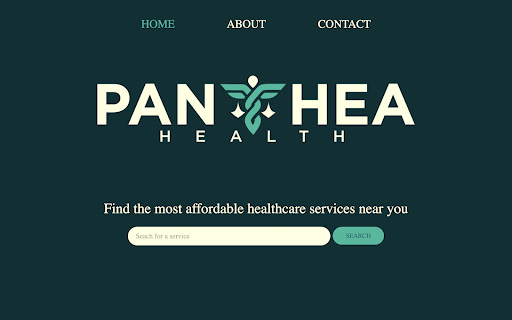Panthea Health empowers people to make more informed, economical healthcare decisions by providing a data-driven, easy-to-use search engine for finding the right healthcare providers near them.

What does it mean to be cutting edge?
Sometimes it can be as simple as mowing someone’s lawn. Or rather, brainstorming a next generation tool to save lives and circumvent frustrations of the healthcare system in the United States for uninsured and underinsured individuals while mowing someone’s lawn.
Point is, residing in Silicon Valley is not necessarily a prerequisite to flourishing as an entrepreneur. Although Donnie Watson, co-founder of Panthea Health, is majoring in chemical engineering at the University of Illinois, he attributes his disruptive startup in the healthcare industry to his entrepreneurial spirit seeded by a lawn care business he started in high school.

The Perks of a High School Side Hustle
Watson’s junior year was somewhat typical to that of most high school students in rural America. Besides school, he had his SATs, extracurriculars, and casual lawn care business that he started himself. Admittedly, Watson was not wearing emerald-colored glasses. He recognized that mowing lawns is not the most glorious way to spend a summer, especially when compared to his friends who lounged around and got tan as lifeguards for three months. Undeniably, though, the money spoke to him. He elaborates on his pleasantly surprising time-to-return ratio saying,
“I was 18 years old making four times their income mowing lawns. And I saw what I could do if I was working for myself, which fueled my entrepreneurial route.”
Watson couldn’t see himself sitting on a lawn mower day in and day out. Nor could he see himself sitting in an office chair directing a company existing to mow people’s lawns for the long term. He didn’t see this as a lifelong gig, but he did see his side hustle as a guiding lesson. This experience made him realize that he didn’t like working for other people and he wanted to be in control of his own destiny. Watson was from there on out empowered to “grab the proverbial reigns of [his] life” and embark on a career that made him feel fulfilled and influential.
But he wasn’t the only person in his hometown of 8,800 people who adopted this mentality. In fact, a lot of people he grew up with owned their owned businesses, a phenomenon that Watson deems a byproduct of rural America:
“There’s no corporate jobs and there’s no opportunity unless you make it for yourself. So I had the privilege of being around a lot of business leaders in the community early on because there simply are a lot of them.”
Today, Watson still owns and operates this lawn care business on the side, and while he has reaped substantial financial reward from it (contributing a pretty penny into his tuition at the University of Illinois), he sees this as a secondary benefit to the network-building his company extends. On one lawn-mowing happenstance, he was able to join forces with one of the most influential people in his life, Jared Baughman. Baughman was Watson’s distant cousin, but the two hadn’t talked business until the day that his venture, Panthea Health, was conceived.

How A Small Town Startup Is Born
Baughman was an insurance broker with an advantageous peek into the healthcare industry. He also knew of Watson as a keen, ambitious student at the University of Illinois, so in casual conversation one day he offered up some sage wisdom. In a couple of months, he mentioned, a law called the No Surprises Act would go into effect requiring hospitals to publicly disclose the price of many of their most popular services. The result of this legislation would be a massive master charge sheet of at least 50,000 cells describing itemized services using nomenclature that the average person would most likely be unable to comprehend, especially given the low level of health literacy among the US population. In fact, nearly 40% of people in the US are considered to have a low level of health literacy, and this new law would certainly not be doing anything to help that cause (CHCS).
If you are among the near majority of the population unfamiliar with the pricing system for healthcare services currently, don’t fret. Sensibly, this topic is
“not something you think of everyday. It’s pretty much only something that comes about when you’re in a bad place healthwise and you’re like ‘oh my gosh, I don’t know any of this stuff, what do I do?’”
Plus, this information has been traditionally nontransparent to the general public, so most of us have been completely in the dark about options for finding affordable healthcare services. But as an example, let’s consider the costs associated with someone seeking treatment for an ear infection.
On your bill, you are not going to see the word “ear infection” with a pre-determined price. Instead, your ledger will contain costs associated with physician time, nurse time, room occupation, and prescription-related services. Understandably so, the current pricing system has deterred individuals, particularly the 30 million people in the US who are uninsured or underinsured, to avoid the doctor altogether for fear of being charged an exuberant amount of money.
There are also several other factors that actively prevent people from seeking more affordable care. First of all, these combined costs, called diagnostic related groups (DRGs), can be quite difficult to predict, with so many variable factors that cannot possibly be accounted for. Secondly, this information was not previously available on the internet, so generalized estimates for each care facility would need to be obtained through lengthy phone call conversations or physical location visits. Lastly, there is an irrationality behind healthcare-seeking behavior, since people tend to associate lower costs with lower quality care, even for services which have no dependency on the deliverer of care (i.e., vaccines, diagnostic testing).
With the incoming law that Baughman had brought to Watson’s attention, concern #2 would be universally solved. Concerns #1 and #3, combined with the fact that these spreadsheets were written in complete jargon, left room for entrepreneurship to enhance the viability of the law for the average citizen. Upon Baughman’s prophetic presentation of this conundrum, the two devised a plan that they felt could make a difference in people’s lives.

The Heart Behind this Healthcare Venture
For Watson, this multi-faceted issue was not just something he sympathized with as a spectator and researcher. Members of his own family had been personally impacted by health issues that caused them to have to struggle through the healthcare system and negotiate prices to avoid astronomical bills. He had also heard horror stories of people close to him being charged thousands of dollars months after receiving medical treatment that they thought had been covered by their insurance, making this a challenge he was adept to tackle.
At first, Watson and Baughman were a bit hesitant as to whether their idea was even feasible. In their minds, a major tech mogul like Google had to be pursuing this concept and would have a working beta at the very least in a couple of months. But to their surprise, major tech companies hadn’t shown out. Thus began the process of team building in a race against time at the speed of innovation.
The Journey Begins
Their idea came to the first of many heads in the classrooms of David Kinley Hall on a chalkboard with a simple triangle drawn on it. Watson was in the process of recruiting teammates, and in front of him sat his future co-founders Siddhant Rao and Aaditya Jain. Both of these incredibly talented and driven partners were tech whizzes, but they were also both international students, so Watson was delivering a very concentrated, nutritious presentation about the healthcare system in America. At the time, they were amazed by how complicated the system was, especially coming from India where many healthcare services can be simply ordered to the home. To help simplify the concepts for Rao and Jain, Watson began diagramming in hopes of helping them grasp the issues Panthea Health aimed to tackle.
The three corners of the triangle represented the three core actors in this system: individuals, healthcare providers, (i.e., hospitals) and insurance companies. In another triangle, he sketched the three constraints on the healthcare system—cost, accessibility, and quality—of which most scholars believe only two can be achieved. Besides the geometric representations, Watson shared with his colleagues the gist of the presentation that he had heard from Baughman. From then on, the team immediately got to work, and in just one week, Rao had built out a beta with nine hospitals in the Champaign area.

The Purpose of Panthea
Moving forward, one of the company’s largest hurdles has been where to get started within the industry. The healthcare system produces about 20% of our country’s GDP and employs about 22 million people, so it was an overwhelming task to decide where exactly they should begin (Census).
Their approach: act as various individuals looking into the system to see who is most in need. For low income, immigrant populations or otherwise uninsured or underinsured individuals, going to the doctor can be scary, especially for problems that seem nonurgent. However, when these mild health concerns build up over time, there is a potential for them to become recurring problems that are much more severe and expensive to treat.
With this in mind, the Panthea team decided to focus on services that are commonly not covered by insurance and those with a low difference in outcome, as we discussed earlier with vaccines, diagnostic tests, MRIs, and mammograms. Vaccines in particular were something that Watson battled with in seeking a yellow fever shot before his trip to Brazil with the Hoeft Technology & Management program. What he found was that his insurance company did not cover optional travel vaccines, and in order to get one at the nearest local hospital, he would need to pay about $850. Systematically, he called several hospitals within what he deemed a reasonable radius, and he found that a hospital about an hour away could give him the shot for just $170. This experience reassured his suspicion about imbalances in hospital pricing methods, as he spent hours calling around getting quotes, which a lot of people might not be able to afford.
Feeling reignited, Watson and his Panthea partners dove headfirst into the hypothetical arms race for an accessible platform that would allow individuals to compare costs of various medical services to find the cheapest option. They also firmly committed to creating a product that was completely free to customers and would instead put the onus on employers to pay for this service that would ultimately reduce the expenses their employees paid in medical treatment.
Thus far through the iVenture program, Panthea Health has re-branded, met with several medical professionals to guide the development of their product, and committed to a beta version of their platform by Demo Day at the end of the summer. Moving forward, the crew aims to create a better world by completely alleviating the stress Americans face going to the doctor and saving lives from chronic conditions left untreated.
As American journalist Glenn Greenwald once said, ”Transparency is for those who carry out public duties and exercise public power,” and by shedding light on health care billing and how money moves within the system, the mission of Panthea is to create a healthier, more equitable world.
To follow their journey, subscribe to our newsletter for more updates.
